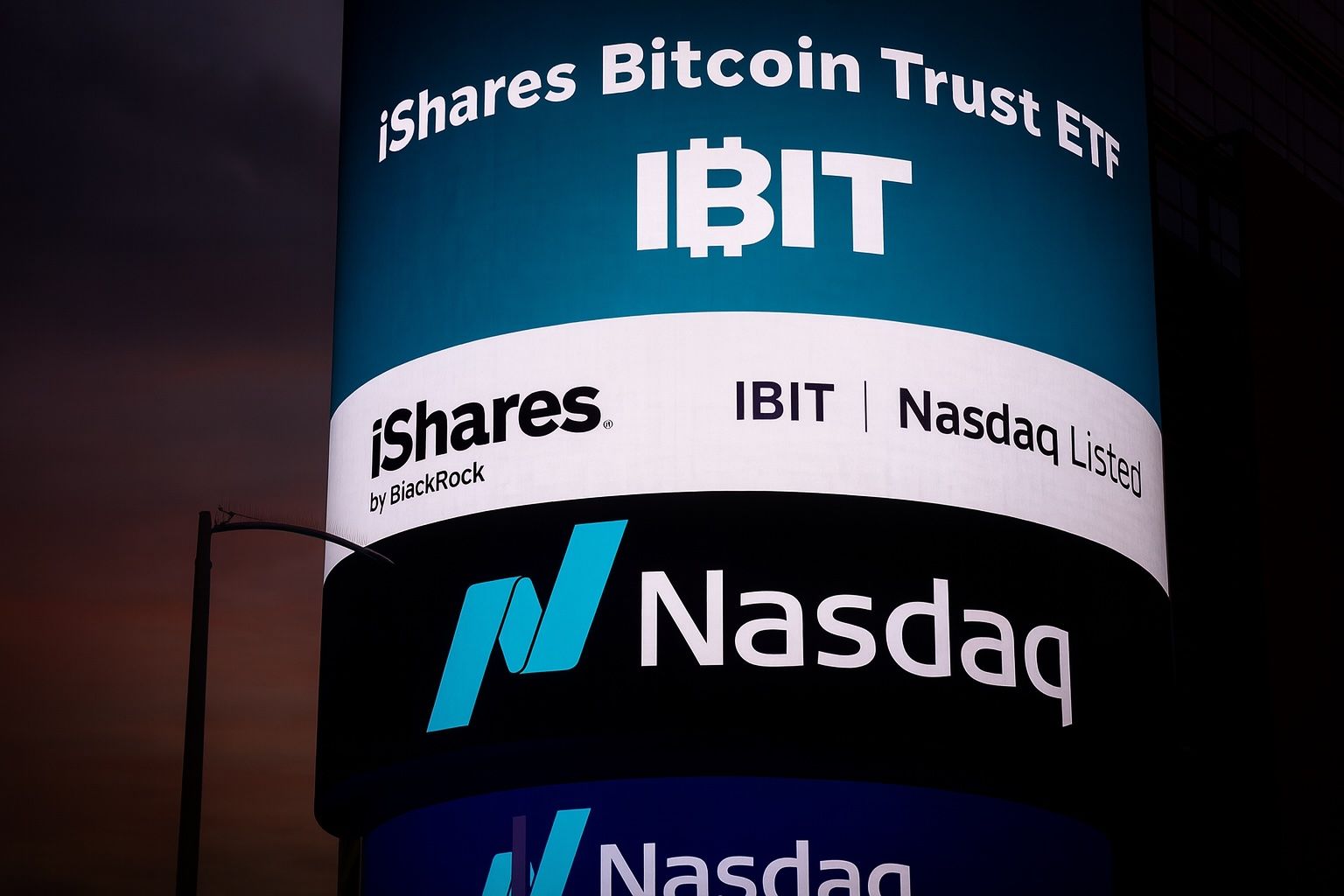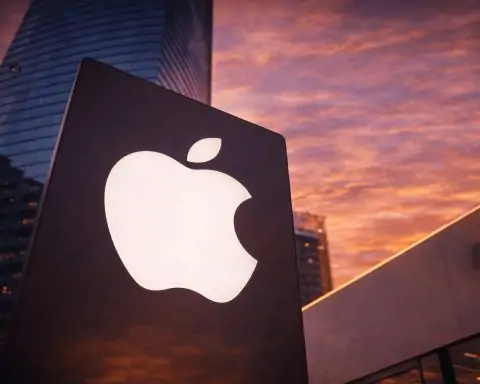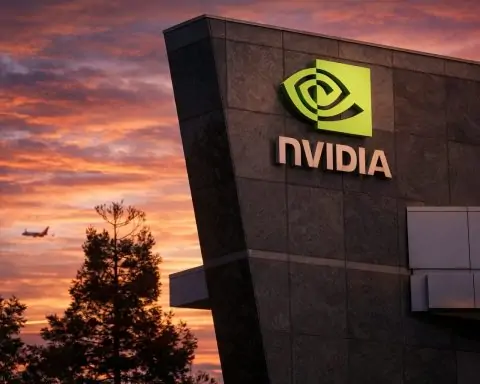- BlackRock’s IBIT Hits Top-20 Milestone: The iShares Bitcoin Trust (IBIT) now ranks among the 20 largest U.S. ETFs, with roughly $90–95 billion in assets under management [1]. Launched in January 2024, IBIT achieved this echelon in under two years – a feat that took gold’s GLD fund much longer [2] [3]. Its expense ratio is just 0.25%, helping attract massive institutional inflows [4].
- Bitcoin Near All-Time High: Bitcoin’s price surged to ~$123,300 by October 3, 2025, within 1.6% of its record peak (~$124,500) [5]. By October 5, BTC broke its all-time high, trading above $125,000 amid a wave of buying [6]. This “Uptober” rally (~15% in a week) drove IBIT’s share price to ~$69-70 (its 52-week high) [7], more than double its low for the year, as the ETF faithfully tracked Bitcoin’s climb.
- Record Inflows Fueling IBIT: A flood of money has poured into Bitcoin ETFs alongside the price rally. In late September and early October, five straight days of net inflows injected nearly $1 billion into Bitcoin funds [8]. On October 1 alone, IBIT pulled in $405.5 million – its largest one-day intake since August [9] – helping push its total net inflows to date above $61 billion [10]. Across all issuers, U.S. spot Bitcoin ETFs saw ~$675–985 million of inflows in a single day (Oct 1–3) [11] [12], underscoring red-hot demand from both institutions and retail investors.
- Unprecedented Trading Volume: IBIT has quickly become one of the most actively traded ETFs. Daily turnover often reaches tens of millions of shares – for instance, ~83 million shares traded on Oct 3 (vs ~45M average) [13]. On Oct 1, IBIT’s volume topped 58 million shares ( ~$3.85 billion) in one day [14]. Such liquidity now rivals crypto-native markets – options on IBIT have grown so popular that its derivatives volume is comparable to Deribit, historically the largest Bitcoin options venue [15] [16]. This shift toward a U.S.-regulated ETF for Bitcoin trading and hedging marks a major institutionalization of the market.
- IBIT Dominates Bitcoin ETF Landscape: BlackRock’s fund commands an estimated 57% of all Bitcoin ETF assets [17], dwarfing competitors. IBIT’s asset base is 3–4× larger than the next biggest ETF – Fidelity’s Wise Origin Bitcoin Fund (~$24–25 billion AUM) [18] – and orders of magnitude above smaller players like ARK’s Bitcoin ETF (ARKB, single-digit billions) and the recently converted Grayscale Bitcoin Trust (GBTC). IBIT’s low fees, liquidity, and BlackRock’s clout have made it the default choice for many institutions [19] [20]. By contrast, GBTC (a former trust) has struggled with outflows and still charges 1.5% fees [21], limiting its appeal.
- Bullish Sentiment and Outlook: The launch of spot Bitcoin ETFs has galvanized Wall Street’s outlook on crypto. Major analysts are upping targets – Standard Chartered predicted BTC could hit ~$135K in the near term (and even ~$200K by year-end in a bull case) [22], while JPMorgan raised its 2025-end forecast from $126K to $165,000, citing Bitcoin’s “inflation hedge” appeal and undervaluation vs. gold [23]. Bloomberg ETF expert Eric Balchunas notes that if IBIT’s growth persists, it could break into the top 10 ETFs by 2026 – “about $50 billion away,” he says, setting an over/under of Christmas 2026 for that milestone [24]. Such projections underscore expectations that Bitcoin ETFs like IBIT will continue to attract heavy investment flows.
- Investment Considerations: Bitcoin ETFs offer regulated, convenient exposure to BTC, but they remain high-risk, volatile assets. Fidelity explicitly warns that products like its Bitcoin fund are meant only for “investors with a high risk tolerance” given that Bitcoin “is highly volatile and could become illiquid,” and that investors “could lose their entire investment.” [25] Prospective IBIT investors should view it as a long-term, speculative allocation – one now increasingly viewed as a legitimate portfolio diversifier, but still prone to sharp swings and regulatory uncertainties.
Uptober 2025: Bitcoin’s Rally and IBIT’s Breakout Moment
Early October 2025 brought a perfect storm of bullish catalysts for Bitcoin – and IBIT was a major beneficiary. After a sluggish summer, Bitcoin erupted in a classic “Uptober” surge, soaring past $120K and closing in on its all-time high [26]. By October 3, BTC reached ~$123,300 intraday, less than 2% shy of its peak price [27]. This momentum carried into the weekend: on October 5, Bitcoin hit a fresh record high around $125,000 [28]. Analysts pointed to multiple drivers behind the rally: safe-haven demand from a U.S. government shutdown and dollar weakness, hopes of Fed easing, and – notably – massive inflows into new Bitcoin ETFs [29] [30].
IBIT’s performance has closely tracked this Bitcoin upswing. The fund’s NAV per share climbed to $69.68 by Oct 3 (its highest to date) [31], reflecting Bitcoin’s ~+77% gain over the past year and ~+29% in the last quarter [32]. In fact, IBIT is up about 175% since inception in Jan 2024 [33], handily outperforming many equity and bond ETFs over that period. Its market price has traded at a slight premium or discount of only a few basis points [34], indicating tight tracking of Bitcoin’s reference index. In short, as Bitcoin goes, so goes IBIT – and Bitcoin’s “strongest-ever start to October” [35] translated into record highs for IBIT’s price as well.
Crucially, trading activity in IBIT has exploded alongside its price. On high-volatility days, IBIT’s dollar volume now rivals major stocks and ETFs. It exchanged over $3.8 billion worth of shares on Oct 1 (≈58 million shares) [36], and regularly trades $2–5 billion+ daily as October progresses. This deep liquidity is a key attraction for institutions – tight spreads (~0.02%) and robust volume make it easy to enter/exit large positions [37]. The surging volume also reflects wider adoption of IBIT as a trading instrument. In fact, options on IBIT have become so popular that by late September the fund’s options open interest (~$32B) was on par with all crypto options on offshore venues like Deribit [38]. “Options are now the dominant derivatives instrument…eclipsing futures,” noted one report, highlighting how IBIT’s option market is reshaping Bitcoin’s volatility profile [39] [40]. This means sophisticated investors can hedge and speculate on Bitcoin via regulated IBIT options, further boosting the ETF’s trading ecosystem.
Massive Inflows as Institutions Embrace Bitcoin ETFs
Perhaps the biggest story of this period is the sheer scale of capital flowing into Bitcoin ETFs, with BlackRock’s IBIT at the epicenter. After years of pent-up demand, U.S. investors finally have a spot Bitcoin ETF – and they’re piling in at an unprecedented rate. Late September to early October 2025 saw record-breaking inflows into Bitcoin funds, coinciding with the price rally. Multiple sources report that in the first week of Q4, over $2.25 billion poured into Bitcoin ETFs globally [41].
On October 3 alone, nearly $985 million went into spot Bitcoin ETFs [42] – a single-day figure that’s astonishing for any asset class. The majority of that went to IBIT. BlackRock’s fund led all peers with $405.5M of inflows on Oct 1 [43] and similarly outsized contributions on adjacent days. Over the span of just three trading days (Sept 29–Oct 1), U.S. Bitcoin ETFs saw ~$676M net inflows, of which IBIT accounted for 60% [44] [45]. By Oct 1, IBIT’s cumulative net creations since launch topped $61.38 billion [46] – highlighting how much new money has entered the fund in under two years. (For context, over 778,000 BTC are now held by IBIT, roughly 4% of Bitcoin’s total supply.)
What’s driving these flows? Institutional adoption is a big part of the story. BlackRock’s ETF has given pensions, endowments, and asset managers a green-lighted conduit into Bitcoin. “Bitcoin, wrapped in a regulated ETF, is now a serious portfolio building block,” as one analyst put it [47]. Many large investors who were previously sidelined by custody and compliance concerns are now allocating via IBIT. Automatic model portfolios and allocation models are starting to include IBIT now that it ranks in the top 20 ETFs [48]. And with in-kind creations (recently approved by the SEC) allowing large institutional traders to swap Bitcoin for IBIT shares directly, the ETF has become an efficient vehicle to deploy capital at scale [49]. In fact, over $1 billion flowed into IBIT in just the first week of October [50], showing that “big money is coming into crypto” through these funds.
Retail investors are participating too – via brokerage accounts and retirement plans – but much of the volume appears institutionally driven. Notably, Bitcoin ETF inflows have been accompanied by outflows from gold funds, hinting at a rotation from gold to “digital gold.” Bank of America recently observed large outflows from gold ETFs as Bitcoin products saw inflows, suggesting investors are shifting safe-haven allocations into BTC [51]. This aligns with the narrative of Bitcoin gaining legitimacy as “the new gold” in portfolios. As JP Morgan analysts wrote, many see Bitcoin as underpriced relative to gold’s market share, and are buying ETFs as an inflation hedge [52].
Sentiment-wise, the steady drumbeat of positive news – ETF inflows, price highs, and even U.S. political support – has created a feedback loop. “Price follows narrative,” as investors say, and right now the narrative is extremely encouraging. Every day seemingly brings another headline of large ETF buys or new crypto-friendly policies. For instance, Bloomberg reported Bitcoin’s rally was being “fuelled by ETF inflows and safe-haven demand” during the U.S. budget standoff [53]. Such stories reinforce confidence, prompting yet more inflows.
IBIT vs. GBTC, ARKB, and FBTC: How the Bitcoin ETFs Stack Up
BlackRock’s IBIT may be the 800-pound gorilla of Bitcoin ETFs, but it’s not alone. The competitive landscape includes offerings from Grayscale, Fidelity, ARK Invest, Bitwise, and others. Here’s how IBIT compares:
- Grayscale’s GBTC (Now an ETF): Grayscale’s Bitcoin Trust was the original vehicle for institutional BTC exposure, but it operated as a closed-end trust with high fees (2%) and often traded at a steep discount or premium to NAV. After a protracted legal battle, GBTC finally converted to an ETF in January 2024 [54]. However, its 1.5% fee remains much higher than peers [55], and crucially, it had accumulated baggage: prior to conversion, GBTC’s shares traded at a deep discount, and once redemptions opened, many investors withdrew. In fact, over 400,000 BTC worth of GBTC holdings have exited since it became an ETF (GBTC’s Bitcoin stash fell from ~617k BTC to ~191k as of mid-2025) [56]. This resulted in shrinking AUM – roughly ~$20–30B now, versus IBIT’s ~$90B. GBTC did see a minor $9 million inflow in early October (its first positive flow in a while) [57] [58], but generally it’s been ceding ground. The reasons are clear: IBIT offers similar pure BTC exposure with only 0.25% fees [59], daily creation-redemption (no big discounts), and the imprimatur of BlackRock. Unless Grayscale slashes fees or finds a niche, IBIT has effectively usurped GBTC’s throne as the go-to Bitcoin fund.
- Fidelity’s Wise Origin Bitcoin Fund (FBTC): Fidelity, another heavyweight, launched its spot Bitcoin ETF concurrently with BlackRock in early 2024. FBTC is IBIT’s closest competitor by size and credibility. As of October 2025, FBTC manages around $24–25 billion in assets [60] – roughly a quarter the size of IBIT. Its market share of flows has been respectable: for example, on Oct 1 it garnered $179M of inflows (second only to IBIT) [61]. Fidelity’s product has identical fees (0.25%) [62] and the backing of Fidelity’s brand/trading infrastructure, making it popular especially among advisors and brokerage clients already in the Fidelity ecosystem. Still, BlackRock’s distribution might has given IBIT an edge: BlackRock captured about 57% of all Bitcoin ETF AUM, whereas Fidelity’s share is closer to ~15% [63] [64]. Both funds are similar in structure (both track the same CME Bitcoin Reference Rate). One minor differentiator: Fidelity has heavily courted RIA platforms and financial advisors with FBTC integration [65] [66], positioning it as an “easy button” for advisors to add crypto. In practice, many institutions simply opted for the liquidity leader (IBIT). Nonetheless, FBTC is expected to remain a strong #2 and could benefit if any issue ever arose with IBIT.
- ARK 21Shares Bitcoin ETF (ARKB): ARK Invest (in partnership with 21Shares) also launched a spot BTC ETF in Jan 2024. Cathie Wood’s ARK was an early proponent of Bitcoin, and ARKB came with a very low 0.21% expense ratio [67] – undercutting BlackRock slightly. However, ARKB’s adoption has been modest relative to IBIT. By Oct 2025 its AUM was around $5 billion (with ~$2.3B in net inflows since launch) [68]. ARKB saw only ~$6M of inflows on Oct 2 [69] and ~$5.9M on Oct 1 [70], indicating far less institutional uptake. Why the gap? ARK lacks the extensive distribution to wirehouses and retirement plans that BlackRock and Fidelity enjoy. ARKB likely attracts a more crypto-forward retail and tech investor segment – those who follow Cathie Wood’s vision – but that’s a narrower pool. The fund’s performance essentially mirrors IBIT (it tracks the same index) and with similar tight spreads. ARK has been vocal about Bitcoin’s long-term potential (Wood famously holds a $1 million BTC target for 2030), which resonates with some investors. Yet for large allocations, liquidity begets liquidity – IBIT’s huge size draws even more volume, making it hard for smaller ETFs like ARKB to close the gap. Still, ARKB offers a viable alternative for those who prefer ARK’s branding or custody setup, and it could see growth if it differentiates (e.g. via portfolio services or if ARK’s broader funds channel capital into it).
- Other Bitcoin ETFs: A handful of other issuers have spot Bitcoin ETFs now trading, though none approach IBIT’s scale. Bitwise launched one (BITC) that gathered a few billion in assets; VanEck, Invesco, WisdomTree, and others also joined the fray in 2024. In aggregate, all U.S. Bitcoin ETFs combined hold about $150–156 billion as of early Oct 2025 [71] [72] – a stunning figure that speaks to how quickly this market grew. BlackRock’s share of that pie (~$90B) underscores its dominance. Many smaller ETFs have unique angles – for example, some offer combined Bitcoin and Ether exposure, others target specific distribution channels. Thus far, however, the spot Bitcoin ETF space has been a “winner-takes-most” scenario, with IBIT (and to a lesser extent FBTC) capturing the lion’s share of assets.
In summary, IBIT enjoys a first-mover (or “first-success”) advantage among Bitcoin ETFs, amplified by BlackRock’s reputation and distribution. It has lower costs and better liquidity than the old GBTC, and far more assets than newer rivals. That said, competition is poised to increase – if crypto markets keep growing, we could see fee wars or more specialized offerings. For now, though, IBIT is essentially the S&P 500 of crypto ETFs – the benchmark against which others are measured.
Broader Context: Market Sentiment, Adoption, and Regulation
The rapid ascent of IBIT is not happening in a vacuum – it’s part of a broader mainstreaming of Bitcoin in 2025. Market sentiment toward crypto has improved markedly thanks to a confluence of factors:
- Regulatory Green Light: After a decade of denying spot Bitcoin ETF applications, U.S. regulators finally relented. In a historic shift, the SEC approved a wave of spot Bitcoin ETFs in January 2024, simultaneously giving the nod to BlackRock, Fidelity, ARK 21Shares, Grayscale’s conversion, and others [73]. This opened the floodgates for institutional adoption. By late 2024, the SEC even allowed ETF issuers to use in-kind creations/redemptions (swapping Bitcoin for shares directly) and permitted options trading on the ETFs [74] [75]. These moves reduced tracking costs and gave sophisticated investors more tools – effectively addressing many past SEC concerns about market manipulation and custody. The result has been a new era of regulated crypto investment. (Notably, Ethereum ETFs have followed suit – the first U.S. spot Ether ETFs launched by October 2025, garnering ~$230M in inflows in their first week [76], a sign that the crypto ETF concept is expanding beyond Bitcoin.)
- Institutional Endorsement: It’s hard to overstate the psychological impact of seeing names like BlackRock, Fidelity, and JP Morgan linked to Bitcoin. What was once dismissed as fringe is now championed by financial titans. BlackRock CEO Larry Fink, who in years past was skeptical, now says Bitcoin has the potential to “transcend international currencies” and even speculated it could “go up to $700,000” per coin if enough institutions embrace it as a hedge against currency debasement [77] [78]. While that sky-high target is hypothetical, it grabbed headlines and lent legitimacy – if the world’s largest asset manager is that bullish, many investors take note. Similarly, traditional banks like Standard Chartered and Citi publicly released six-figure price forecasts for Bitcoin, explicitly citing ETF inflows and adoption by big money as key drivers [79] [80]. Every time a Wall Street household name voices support, it further validates Bitcoin as an investable asset class. This growing chorus of endorsement contributed to 2025’s optimistic mood.
- Macro Tailwinds: The macroeconomic backdrop has also played a role in both Bitcoin’s price and the appetite for Bitcoin ETFs. With global inflation still a concern and U.S. fiscal uncertainty (e.g. the early October government shutdown and political gridlock), investors have been seeking inflation hedges and uncorrelated assets. Bitcoin has benefitted from a narrative as “digital gold.” Indeed, as Bitcoin hit new highs, gold was also rallying to record levels – a sign that safe-haven demand was broad-based [81]. The difference is, via ETFs like IBIT, Bitcoin is now almost as accessible as gold. Additionally, expectations that the Federal Reserve might cut interest rates in late 2025 have boosted risk assets. Bitcoin historically performs well in easing cycles, and the mere hope of rate cuts has been cited by analysts as fuel for the recent crypto rally [82]. Even the weakening dollar (due to rate pause speculation and the budget impasse) indirectly helped Bitcoin climb (as BTC is priced inversely to USD strength) [83]. So the macro narrative – a mix of inflation worries, policy uncertainty, and a possible end to tightening – created a favorable environment for alternative assets like Bitcoin, drawing more allocations into IBIT.
- Continued Tech and Adoption Strides: Beyond ETFs, the broader crypto industry saw developments that reinforced Bitcoin’s staying power. Major companies like MicroStrategy kept accumulating Bitcoin (touting record holdings worth $19B+ at Q3 2025 prices) and celebrated the uptick as vindication of their strategy [84] [85]. Payment firms and fintechs advanced crypto integration (e.g. rumors of Tesla’s Bitcoin holdings surging in value rekindled chatter of corporate BTC treasuries) [86]. On the policy side, while U.S. regulators are more welcoming to ETFs, they continue to scrutinize crypto exchanges and stablecoins – yet the fact that a Bitcoin ETF got approved at all signaled a thawing that many see as part of a longer-term regulatory acceptance. Internationally, several countries and financial centers (Europe, Canada, Asia) already had crypto ETPs or were moving toward them, so the U.S. catching up removed a big overhang. All of this contributes to a sense that Bitcoin is now “mainstream-ready.” In the words of a CoinDesk report, IBIT’s rise shows “Bitcoin has crossed into the institutional mainstream…allocators no longer need private keys or special custody – just a ticker.” [87].
The confluence of these factors – positive regulation, high-profile endorsements, macro hedging, and ongoing adoption – created perhaps the most supportive backdrop for Bitcoin in its history. And the IBIT ETF sits at the nexus of these trends, as both a beneficiary and an accelerant. It transforms the intangible idea of Bitcoin into a familiar financial product, bridging the crypto and traditional finance worlds. Little wonder that observers have dubbed this the start of a “Spot ETF era” for crypto [88]. As one strategist quipped, “allocators no longer need to learn cold storage or worry about exchanges – they have a regulated vehicle. That’s a game-changer.”
Expert Forecasts and Analysis: What’s Next for IBIT and Bitcoin ETFs?
With Bitcoin pushing new highs and IBIT shattering expectations, experts across finance are issuing bold forecasts for the coming months and years. Here are some highlights of what market watchers predict:
- Bitcoin Price Targets Soar: As mentioned, several major banks have dramatically raised their Bitcoin outlook in light of ETF-driven inflows. Standard Chartered’s Geoff Kendrick made waves on Oct 3 by predicting Bitcoin would imminently break its ~$124K record and could reach $135,000 in the short term, even $200K by end-2025 under bullish conditions [89]. This was one of the most aggressive targets from a traditional bank, signaling how sentiment has shifted. JPMorgan’s research team, in a note on Oct 2, upped their year-end target to $165,000 (from $126K prior) and argued Bitcoin could be worth 40% more if equated to gold’s risk-adjusted returns [90]. Citi’s analysts projected around $133,000 by Dec 2025 (base case), with a potential for $180K+ in a “bull case” 12-month scenario if inflows continue unabated [91]. While not all analysts are so optimistic (some caution that if the economy worsens, Bitcoin could temporarily pull back to the $80Ks [92]), the overall tone from large institutions is the rosiest it’s ever been. “Wall Street and crypto analysts alike updated their forecasts upward,” as one report summarized, noting that even formerly conservative banks now see six-figure prices as feasible [93].
- IBIT’s Growth Trajectory: ETF analysts are similarly bullish on IBIT’s future. Bloomberg’s senior ETF analyst Eric Balchunas highlighted IBIT’s stunning rise – hitting $90B AUM in ~21 months – and mused that entering the top 10 ETFs is only a matter of time [94] [95]. “If the last 12 months are repeated, it may not take long… If forced, I’d set the over/under for Christmas 2026,” Balchunas said of IBIT cracking the top ten by size [96]. To put that in perspective, the top 10 includes behemoths like the SPDR S&P 500 ETF (SPY) and Vanguard’s Total Stock Market fund. IBIT reaching that league would have been unthinkable a few years ago – but now doesn’t sound far-fetched, given it’s already top-20 and still growing fast. Analysts point out that Q4 is historically Bitcoin’s strongest season, and if BTC continues climbing, IBIT’s AUM could swell further from both price appreciation and fresh inflows [97] [98]. Another consideration: international expansion. BlackRock could potentially cross-list IBIT in other jurisdictions or launch feeder funds, which may bring even more assets in. However, the biggest swing factor is simply Bitcoin’s price: a move to, say, $150K per BTC would organically boost IBIT’s assets by ~25% even without new money.
- Market Impact Considerations: Some experts are analyzing how the growing ETF presence is affecting the Bitcoin market itself. A report by analysts at Unchained noted that ETF flows are creating a positive feedback loop – new share creations require buying spot Bitcoin, which can push the price up, attracting more inflows, etc. [99]. They also observed that with IBIT’s options market maturing, volatility has dampened relative to past cycles [100] [101]. More liquidity and hedging tools mean Bitcoin’s price may behave somewhat more like a traditional asset (with more predictable liquidity and less dramatic swings) – though it’s still very volatile. The consensus is that ETFs have “tighter spreads, reduced slippage, and more predictable liquidity” compared to the old ways of accessing Bitcoin [102]. This could further encourage large investors to participate, believing they won’t distort the market as easily. However, some analysts caution that if sentiment reverses, ETFs could just as quickly become conduits for outflows, putting downward pressure on BTC. So far, there’s little sign of that – early October saw essentially zero net outflow days.
- Broader Crypto and ETF Developments: The success of Bitcoin ETFs is already spurring interest in other crypto funds. Ethereum spot ETFs launched in the U.S. around the first week of October 2025 and saw over $230M of inflows in just five days [103] – a strong start given ETH’s smaller market cap. This suggests a path for multi-asset crypto ETFs or other single-asset products (for example, a spot Bitcoin-Ether combo ETF has been floated by some issuers). Industry experts expect that if IBIT and friends continue to thrive, the SEC may warm to additional offerings – perhaps ETFs for other top coins (though regulatory clarity for anything beyond BTC and ETH is still lacking). Globally, countries like Canada, Brazil, and in Europe had Bitcoin ETPs earlier and are now seeing volume shift to the U.S., given IBIT’s liquidity. Some forecasts see the U.S. becoming the center of price discovery for Bitcoin thanks to these ETFs, much as it is for gold.
- Long-Term Vision: Proponents like ARK’s Cathie Wood maintain ultra-bullish long-term targets (e.g. $1 million Bitcoin by 2030) predicated on the idea of “institutional supercycle” – the notion that over the next decade, a meaningful percentage of institutional assets (pensions, sovereign wealth, etc.) will allocate a few percent to Bitcoin. Larry Fink alluded to this when he recounted a sovereign wealth fund asking whether to put 2% or 5% into BTC – if such allocations become norm, “market dynamics could drive Bitcoin to remarkable heights,” Fink said [104] [105]. BlackRock’s own analysts haven’t published a price target, but the company’s actions (like buying $600M of Bitcoin in a single day for IBIT in Jan 2025) speak louder than words [106] [107]. The long-term bullish case is that Bitcoin ETFs will unlock a wall of money from investors who never touched crypto before. Indeed, we’re seeing early evidence: total crypto fund assets (Bitcoin + Ether ETFs, etc.) now easily exceed $160B – still small relative to global markets, but up exponentially from virtually zero two years ago.
In summary, expert analysis on IBIT and the Bitcoin ETF boom ranges from optimistic to outright euphoric. Near-term, many see the momentum continuing through the end of 2025, barring any extraneous shock. Over the long-term, the entrance of products like IBIT is fundamentally altering Bitcoin’s investor base and narrative – arguably making outcomes like six-figure prices more sustainable. Of course, risks remain (more on that below), but there’s a palpable sense that a corner has been turned in the maturation of Bitcoin as an asset.
Is IBIT a Good Investment? – Risks and Outlook for Investors
For investors eyeing the iShares Bitcoin Trust ETF, the allure is clear: IBIT offers pure Bitcoin exposure with the convenience of an ETF. You get to participate in Bitcoin’s upside without needing to manage wallets, worry about hacks, or navigate crypto exchanges. IBIT can be held in brokerage accounts, IRAs, and other traditional accounts, making it accessible to a broad range of market participants. Its massive size and backing by BlackRock lend it credibility and tight tracking. And with an expense ratio of 0.25%, it’s a relatively low-cost way to get Bitcoin exposure (cheaper than many crypto funds or trusts of the past) [108].
However, potential investors must consider their risk tolerance. By design, IBIT’s value directly follows Bitcoin’s price – meaning it inherits all the volatility of Bitcoin. And Bitcoin remains an extremely volatile asset: 20–30% price swings in a single month (or even week) are not uncommon. During bear markets, Bitcoin has historically fallen over 70% from its highs. Nothing about wrapping BTC in an ETF changes its risk profile. BlackRock themselves caution in the prospectus that “investment in the Trust is speculative” and that Bitcoin could theoretically even become worthless if adoption fails. As Fidelity’s fund description bluntly states, these Bitcoin ETFs are “for investors with a high risk tolerance” and even then, one “could lose their entire investment.” [109]. That is a strong warning – essentially, only invest what you can afford to lose and consider Bitcoin a small part of a diversified portfolio.
Investors should also be aware of regulatory and operational risks. While the ETF structure eliminates a lot of headaches (like managing private keys), it introduces other considerations: IBIT’s custody of actual bitcoins (handled by a third-party custodian) is subject to rigorous security, but any failure there would impact the fund. Additionally, the SEC could change its stance or impose new restrictions on crypto ETFs in the future (for example, if market conditions or politics shift). There’s also the risk of price decoupling in extreme scenarios – though IBIT’s market price closely tracks NAV, in a sudden market closure or extreme stress, dislocations could occur temporarily. The fund’s liquidity thus far has been excellent, but in a crisis one can’t guarantee the same depth. These are similar to risks with commodity ETFs (like GLD for gold) – rare, but worth noting.
On the flip side, IBIT’s long-term outlook is strongly tied to Bitcoin’s long-term thesis. If you believe Bitcoin will continue to appreciate as a scarce digital asset with growing global adoption, then IBIT is a convenient proxy for that belief. The long-run drivers would be things like further institutional adoption (imagine more corporations putting Bitcoin on balance sheets, or more nations embracing it akin to digital gold), technological improvements (the Bitcoin network becoming more efficient or scalable via layers), and macro trends (like younger generations favoring crypto or continual distrust in fiat currencies). Many of those drivers seem to be moving in a positive direction as of 2025. The next Bitcoin halving (slated for April 2024) will cut new supply issuance in half, an event that historically has preceded multi-year bull runs – that could be another tailwind in play for IBIT’s underlying asset.
In terms of portfolio role, IBIT can provide diversification benefits since Bitcoin’s correlation with equities has often been low (though it does fluctuate). Some allocators view a small Bitcoin position (via an ETF like IBIT) as “insurance” against currency debasement or as an asymmetric return opportunity. During 2025, we’ve seen examples of Bitcoin acting as a risk asset at times (rallying alongside stocks when liquidity is ample) and as a safe-haven at other times (spiking during the U.S. shutdown and bond market worries) [110] [111]. This dual nature makes it tricky – Bitcoin isn’t a pure hedge like gold, but it’s also not strictly correlated to stocks. A prudent approach some experts suggest is a small allocation (1–5% of a portfolio) to Bitcoin via ETFs, which can potentially enhance returns without unduly jeopardizing the whole portfolio, given that even a 5% allocation that 10X’s can significantly impact overall performance (conversely, a 5% that goes to zero only shaves 5% off the total).
Ultimately, the long-term outlook for IBIT is as bright or uncertain as that of Bitcoin itself. If one subscribes to the many bullish forecasts (six-figure or even seven-figure BTC in the future), then IBIT’s assets and share price could grow dramatically, possibly making it one of the largest ETFs in history. Indeed, one could argue Bitcoin’s fixed supply and increasing demand (now turbocharged by ETF access) create a structurally upward price bias in the long term – though not in a straight line. On the other hand, skeptics point out that Bitcoin has no cash flow and its valuation is driven purely by sentiment and adoption; if either wanes, it could languish or crash. Regulatory crackdowns, tech failures, or a macro scenario like rapidly rising interest rates could also put the brakes on Bitcoin’s rise again.
Our Take: IBIT is a groundbreaking investment vehicle that has swiftly brought Bitcoin to the portfolios of millions. Its short-term performance has been stellar (mirroring Bitcoin’s huge gains in 2024–25), and the current market zeitgeist is very positive. Looking ahead, investors considering IBIT should be prepared for high volatility and treat it as a long-term speculative holding rather than a short-term trade (timing crypto markets is notoriously difficult). The emergence of products like IBIT strengthens the case for Bitcoin’s longevity – it’s now entrenched on Wall Street – but it doesn’t eliminate the fundamental risks of the asset. As always, due diligence and prudent sizing are key. For those who believe in Bitcoin’s story, IBIT offers an accessible way to ride that journey; for those on the fence, the ETF won’t remove all doubt but certainly makes dipping a toe easier.
Bottom line: BlackRock’s iShares Bitcoin Trust has stormed onto the scene, reshaping the crypto investment landscape in 2025. It provides unprecedented access to Bitcoin and is shattering records in the ETF industry. The coming months will test whether the enormous inflows and optimism can be sustained. If Bitcoin’s momentum continues, IBIT may well keep climbing in both size and price, further cementing its status as the flagship Bitcoin fund. Investors should buckle up for the ride – volatility, upside, and all – because with IBIT in the mix, Bitcoin has truly gone mainstream.
Sources: Recent market data and expert commentary were drawn from ts2.tech’s October 2025 analysis of the crypto rally [112] [113], CoinDesk and Yahoo Finance reports on IBIT’s inflows and AUM milestones [114] [115], BlackRock’s official IBIT filings [116] [117], Coinfomania and Bloomberg insights on ETF flows [118] [119], as well as statements from industry leaders like Larry Fink [120] and Eric Balchunas [121]. (All referenced materials are cited in-line above for further reading.)
References
1. www.coindesk.com, 2. debifi.com, 3. debifi.com, 4. coinfomania.com, 5. ts2.tech, 6. www.reuters.com, 7. www.blackrock.com, 8. ts2.tech, 9. www.coindesk.com, 10. www.coindesk.com, 11. ts2.tech, 12. coinfomania.com, 13. www.blackrock.com, 14. coinfomania.com, 15. simplywall.st, 16. www.coindesk.com, 17. www.coindesk.com, 18. coinfomania.com, 19. coinfomania.com, 20. coinfomania.com, 21. www.coindesk.com, 22. ts2.tech, 23. ts2.tech, 24. www.coindesk.com, 25. institutional.fidelity.com, 26. ts2.tech, 27. ts2.tech, 28. www.reuters.com, 29. ts2.tech, 30. ts2.tech, 31. www.blackrock.com, 32. www.blackrock.com, 33. www.coindesk.com, 34. www.blackrock.com, 35. ts2.tech, 36. coinfomania.com, 37. www.blackrock.com, 38. www.coindesk.com, 39. www.coindesk.com, 40. www.coindesk.com, 41. ts2.tech, 42. ts2.tech, 43. www.coindesk.com, 44. coinfomania.com, 45. coinfomania.com, 46. www.coindesk.com, 47. debifi.com, 48. debifi.com, 49. debifi.com, 50. ts2.tech, 51. ts2.tech, 52. ts2.tech, 53. ts2.tech, 54. www.coindesk.com, 55. www.coindesk.com, 56. thedefiant.io, 57. coinfomania.com, 58. coinfomania.com, 59. coinfomania.com, 60. coinfomania.com, 61. coinfomania.com, 62. seekingalpha.com, 63. www.coindesk.com, 64. coinfomania.com, 65. institutional.fidelity.com, 66. institutional.fidelity.com, 67. www.21shares.com, 68. coinfomania.com, 69. debifi.com, 70. coinfomania.com, 71. coinfomania.com, 72. coinfomania.com, 73. www.coindesk.com, 74. debifi.com, 75. debifi.com, 76. ts2.tech, 77. www.nasdaq.com, 78. www.nasdaq.com, 79. ts2.tech, 80. ts2.tech, 81. www.reuters.com, 82. ts2.tech, 83. www.reuters.com, 84. ts2.tech, 85. ts2.tech, 86. ts2.tech, 87. debifi.com, 88. ts2.tech, 89. ts2.tech, 90. ts2.tech, 91. ts2.tech, 92. ts2.tech, 93. ts2.tech, 94. www.coindesk.com, 95. www.coindesk.com, 96. www.coindesk.com, 97. debifi.com, 98. debifi.com, 99. debifi.com, 100. www.coindesk.com, 101. www.coindesk.com, 102. debifi.com, 103. ts2.tech, 104. www.nasdaq.com, 105. www.nasdaq.com, 106. www.nasdaq.com, 107. www.nasdaq.com, 108. coinfomania.com, 109. institutional.fidelity.com, 110. ts2.tech, 111. ts2.tech, 112. ts2.tech, 113. ts2.tech, 114. www.coindesk.com, 115. www.coindesk.com, 116. www.blackrock.com, 117. www.blackrock.com, 118. coinfomania.com, 119. www.coindesk.com, 120. www.nasdaq.com, 121. www.coindesk.com










